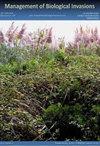Environmental DNA detection of the invasive mussel Mytella strigata as a surveillance tool
IF 1.2
4区 环境科学与生态学
Q3 BIODIVERSITY CONSERVATION
引用次数: 3
Abstract
The American charru mussel Mytella strigata (Hanley, 1843) is an invasive species of great concern along the shores of North America and Asia. As with most invasive mussels, it is very difficult to eradicate once established. Surveillance therefore plays a vital role in controlling its spread. Molecular tools like environmental DNA (eDNA) have proved to be useful in recent years to assist in the early detection and management of invasive species, with considerable advantages over conventional methods like substrate monitoring and sampling, which can be relatively laborious and time-intensive. This technique can be particularly useful in the initial stages of invasion when the population density is often too low to be detected by visual surveys alone. In the present study, we developed a species-specific quantitative polymerase chain reaction (qPCR) approach targeting a cytochrome c oxidase subunit I (COI) DNA fragment aimed at detecting the presence of M. strigata from water samples. We also investigated the relationship between mussel cover and eDNA concentration. Our approach was tested on coastal seawater samples from 14 sites in Singapore, supported by conventional visual quadrat surveys. The results showed clear, positive M. strigata eDNA detection for all sites where this species was observed visually during field surveys. However, there was a weakly negative correlation between percent mussel cover and eDNA concentration, indicating that mussel abundance could not be estimated reliably using seawater eDNA alone. Nevertheless, this study underscores the effectiveness of eDNA in informing the presence and distribution of M. strigata along extensive coastlines comprising different habitats. This approach contributes to a robust toolkit for routine surveillance at sites where invasion may be impending to control the spread of the invasive mussel.环境DNA检测对入侵贻贝的监测作用
美洲白贻贝Mytella strigata (Hanley, 1843)是北美和亚洲沿岸非常关注的入侵物种。与大多数入侵贻贝一样,一旦形成就很难根除。因此,监测在控制其传播方面起着至关重要的作用。近年来,环境DNA (eDNA)等分子工具在协助入侵物种的早期检测和管理方面已被证明是有用的,与传统方法(如底物监测和采样)相比,它们具有相当大的优势,这些方法相对费力且耗时。这种技术在入侵的初始阶段尤其有用,因为此时的种群密度通常太低,仅凭目测无法检测到。在本研究中,我们建立了一种针对细胞色素c氧化酶亚基I (COI) DNA片段的物种特异性定量聚合酶链反应(qPCR)方法,旨在检测水样中是否存在糙纹单胞菌。我们还研究了贻贝盖度与eDNA浓度的关系。我们的方法在新加坡14个地点的沿海海水样本上进行了测试,并得到了传统视觉样方调查的支持。结果表明,在野外调查中,所有目测到的地点都能检测到明显阳性的斜纹单胞菌eDNA。然而,贻贝盖度百分比与eDNA浓度呈弱负相关,表明仅使用海水eDNA不能可靠地估计贻贝丰度。尽管如此,本研究强调了eDNA在包括不同栖息地的广泛海岸线上的存在和分布方面的有效性。这种方法有助于在入侵可能即将到来的地点进行常规监测,以控制入侵贻贝的传播。
本文章由计算机程序翻译,如有差异,请以英文原文为准。
求助全文
约1分钟内获得全文
求助全文
来源期刊

Management of Biological Invasions
Agricultural and Biological Sciences-Ecology, Evolution, Behavior and Systematics
CiteScore
3.40
自引率
6.70%
发文量
21
审稿时长
16 weeks
期刊介绍:
Management of Biological Invasions, established in 2010 by Dr. Elias Dana, is an open access, peer-reviewed international journal focusing on applied research in biological invasions in aquatic and terrestrial ecosystems from around the world. This journal is devoted to bridging the gap between scientific research and the use of science in decision-making, regulation and management in the area of invasive species introduction and biodiversity conservation.
Managing biological invasions is a crisis science, with Management of Biological Invasions aiming to provide insights to the issues, to document new forms of detection, measurements and analysis, and to document tangible solutions to this problem.
In addition to original research on applied issues, Management of Biological Invasions publishes technical reports on new management technologies of invasive species and also the proceedings of relevant international meetings. As a platform to encourage informed discussion on matters of national and international importance, we publish viewpoint papers that highlight emerging issues, showcase initiatives, and present opinions of leading researchers.
 求助内容:
求助内容: 应助结果提醒方式:
应助结果提醒方式:


